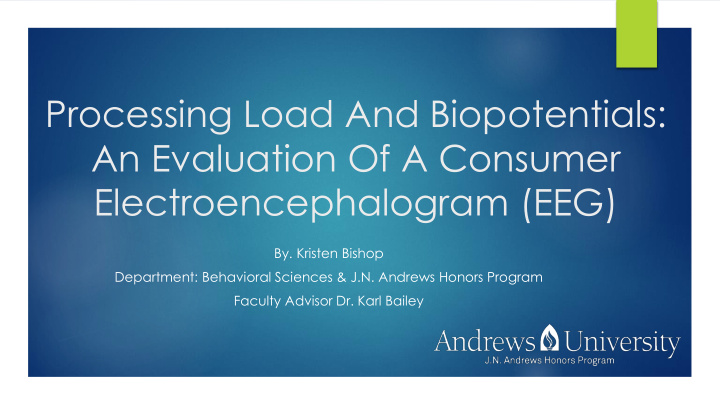



Processing Load And Biopotentials: An Evaluation Of A Consumer Electroencephalogram (EEG) By. Kristen Bishop Department: Behavioral Sciences & J.N. Andrews Honors Program Faculty Advisor Dr. Karl Bailey
Introduction Popular Psychology Marketing for consumers Testing of Devices
NeuroSky A single channel Electroencephalogram device from NeuroSky Concentration & Meditation Claims of this device have not been tested The purpose of my study is to test this device, specifically NeuroSky claims of concentration.
Literature Review Concentration can be measured by looking at alpha waves on an EEG readout (Klimesch, 1999). Concentration can also be measured using pupil dilation. Pupil dilation studies (Kahneman & colleagues, 1969; Bijleveld, Custards & Aarts). Hypothesis: Pupil dilation does indeed measure concentration, and if the NeuroSky device measures concentration, the readout of the EEG output should correlate with the pupil dilation studies.
How the Pupil works Brain & Physiological Stress Sympathetic responses nervous system Work Fear Difficult tasks Environment Pupil Dilation
Experiment 1: Methodology Replicate Kahneman and colleagues 1969 study. Experiment direction X-axis: Size of Experimental pupil conditions Y-Axis: Time of the experiment
Experiment 1: Methodology Replicated Kahneman and colleges 1969 study Task of the subject Addition problems while on the eye tracker Methodology List of 4 Add (0,1,3) Response random numbers
Experiment 1: Methodology Equipment 60 Hz dark pupil infra-red eye tracker.
Experiment 1: Methodology Set-up with Subject Screen subjects looked at.
Experiment 1: Methodology Participants 29 students 4 males & 25 females 3 removed from data analysis
Experiment 1: Results Original study Experiment 1
Experiment 1: Results
Experiment 1: Statistics Eye tracking data was split into 4 groups R 3.0.2 using the aov function A one-way ANOVA was done on each group Frames F(2,50) P * Significant values 0-200 2.16 .13 200-400 2.92 .06 400-600 5.59 *.01 0-600 4.02 *.02
Experiment 1: Conclusions Conclusion 2 Conclusion 1 Conclusion 3 1969 study is accurate in their Task difficulty, or concentration, We found the biggest increase in finding and is replicable. can be measured using an eye pupil size in the add 1 condition tracker. instead of the add 3 condition
Experiment 2: Methodology Same methodology as experiment 1, but with the NeuroSky device. 31 subjects 8 males 24 females 5 removed from data analysis ( for track loss and recording failure)
Experiment 2: Methodology NeuroSky Headband
Experiment 2: Conclusions Similar waves as found in the 1969 study and in experiment 1
Experiment 2: Conclusions Eye study EEG Study The curves of the lines for both the eye data and EEG data are very similar
Positive correlation: the lines are moving together X-axis: ACF = Auto correlation function, Significant level correlation(r) number of p = .05 Negative correlation: the lines are moving apart Y-axis: Lag = Time difference between the Positive lag: Eye Negative lag: EEG lines in seconds wave preceding wave preceding EEG wave the eye wave
Experiment 2: Statistics A cross-correlation was done to see how similar the lines were.
Experiment 2: Results Positive correlation with a negative lag Significant negative correlation with a positive lag
Experiment 2: Results A positive correlation with a negative lag A significant negative correlation with a positive lag
Experiment 2: Results One Peaks Two Peaks
Experiment 2: Results Significant positive correlation with a negative lag Negative correlation with a positive lag
Experiment 2: Results What this means Only one condition fit the Brain/pupil model The baseline and add 3 condition are almost identical The NeuroSky device, actually measures concentration. More sensitive than pupil dilation measurements
Implications & Limitations Implications Limitations Can be used for simple studies. Single channel Classroom use Sampling rate Layperson use Low cost
Concluding Thoughts The claims of the NeuroSky device are true regarding concentration. Laypeople are really getting what they believe they are buying. This equipment has been validated for use in teaching and simple research projects. Example: teaching EEG in physiological psychology class
Selected Bibliography Bijleveld, E., Custers, R., & Aarts, H. (2009). The unconscious eye opener: Pupil dilation reveals strategic recruitment of resources upon presentation of subliminal reward cues. Psychological Sciences, 20(11), 1313-1351. doi 10.1111/j.1467-9280.2009.02443.x Kahneman, D., Tursky, B., Shapiro, D., & Crider, A. (1969). Pupillary, heart rate, and skin resistance changes during a mental task. Journal of Experimental Psychology, 79(1), 614- 167. Klimesch, W. (1999). EEG alpha and theta oscillations reflect cognitive and memory performance: a review and analysis. Brain Research Review, 29, 169-195. Racine, E., Bar-Ilan, O., & Illes, J. (2006). Brain imaging: A decade of coverage in print media. Science Communications, 28(1), 122-143. doi: 10.1177/1075547006291990 Racine, E., Bar-Ilan, O., & Illes, J. (2005). FMRI in the public eye. Nature Reviews Neuroscience, 6, 159-164. doi: 10.1038/nrn1609
Special Thanks Dr. Karl Bailey, Dr. L. Monique Pittman, Charles Abreu & Eric Blue
Questions.
Recommend
More recommend